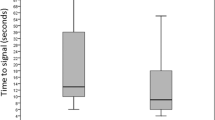Abstract
When deciding an appropriate upper limit for pulse oxygen saturation (SpO2) in preterm infants the usefuleness of current data is limited by the fact that previous studies have examined a population of more mature infants and children or have applied various exclusion criteria which produce results unrepresentative of clinical practice. We tested the hypothesis of previous workers that maintaining the SpO2 below 98% would ensure an arterial oxygen tension (PaO2) less than 12 kPa. A total of 477 simultaneous measurements ofPaO2 and SpO2 were made using Ohmeda Biox oximeters on 43 infants who were less than 33 weeks gestation and receiving supplementary oxygen. Of 435 measurements performed when the SpO2 was 97% or less, 26 (6%) had aPaO2 greater than 12 kPa. Further examination of the data showed that of 108 estimations performed when the SpO2 was less than 94%, none had aPaO2 greater than 12kPa.
Conclusion
When using Ohmeda Biox pulse oximeters an upper limit of 97% for SaO2 is not effective in preventing hyperoxaemia; however, a linit of 93% is likely to maintain thePaO2 below 12 kPa.
Similar content being viewed by others
References
Bucher HU, Fanconi S, Baeckert P, Duc G (1989) Detection of hyperoxaemia in newborn infants by pulse oximetry. Pediatrics 84:226–230
Greenough A, Morley CJ, Roberton NRC (1992) Pulmonary diseases of the newborn. In: Roberton NRC (ed) Textbook of neonatology Churchill Livingstone, Fdinburgh, p. 407
Hay WW, Thilo E, Curlander JB (1991) Pulse oximetry in neonatal medicine. Clin Perinatol 18:441–472
Joint Working Group of the British Association of Perinatal Medicine and the Research Unit of the Royal College of Physicians (1992) Development of audit measures and guidelines for good practice in the management of neonatal respiratory distress syndrome. Arch Dis Child 67:1221–1227
Nunn JF (1989) Applied respiratory physiology. Butterworths, London, pp 263–267
Poets CF, Wilken M, Seidenberg J, Southall DP, Von der Hardt H (1993) Reliability of a pulse oximeter in the detection of hyperoxaemia. J Pediatr 122: 87–90
Southall DP, Bignall S, Stebbens VA, Alexander JR, Rivers RPA, Lissauer T (1987) Pulse oximeter and transcutanous arterial oxygen measurements in neonatal and paediatric intensive care. Arch Dis Child 62: 882–888
Walsh MC, Noble LM, Carlo WA, Martin RJ (1987) Relationship of pulse oximetry to arterial oxygen tension in infants. Crit Care Med 15:1102–1105
Wasunna A, Whitelaw AGL (1987) Pulse oximetry in preterm infants. Arch Dis Child 62:957–971
Author information
Authors and Affiliations
Rights and permissions
About this article
Cite this article
Cochran, D.P., Shaw, N.J. The use of pulse oximetry in the prevention of hyperoxaemia in preterm infants. Eur J Pediatr 154, 222–224 (1995). https://doi.org/10.1007/BF01954276
Received:
Accepted:
Issue Date:
DOI: https://doi.org/10.1007/BF01954276




